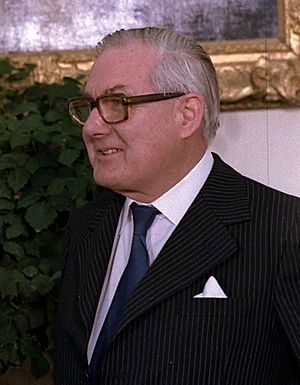Green pound facts for kids
The green pound was a special way to calculate money in the United Kingdom. It was used to figure out how much financial help farmers received from the European Union (EU). This system was part of the EU's Common Agricultural Policy and was used until 1999.
Contents
Why the Green Pound Existed
Before the euro currency, countries in the European Economic Community (EEC) needed a way to manage money for farming. In 1962, they decided to use their own special accounting unit. This unit was first linked to the value of gold.
Later, some currencies like the French franc and German Deutsche Mark changed value. Governments worried that if regular currency rates were used, farmers' incomes would go up and down too much. They wanted stable prices for farmers.
So, they created special fixed exchange rates just for farming. These were called 'agricultural conversion rates' or 'green exchange rates'. When the United Kingdom joined the EEC on January 1, 1973, its special rate became known as the green pound.
How the Green Pound Changed
The value of the green pound could be changed, but it needed agreement from the governments. This made the green pound a big political topic. Sometimes, the green pound was worth much more than the regular pound sterling. This meant food prices in Britain were kept low, but farmers earned less.
Political Debates and Changes
In January 1978, the National Farmers Union (NFU) wanted the green pound's value to drop. This would help British farmers earn more. However, other groups worried it would make food more expensive.
The government at the time, led by James Callaghan, wanted to lower the green pound's value by 5%. But during a vote in Parliament, other parties and some of Callaghan's own party members voted for a bigger drop of 7.5%. This was a defeat for the government.
The government believed a 5% drop was needed to help British beef and pig farmers. They faced strong competition from other countries. This change was expected to increase food costs by about 1%. The government applied the change slowly, starting with livestock.
The green pound's value continued to be an issue in later elections. For example, in 1989, the head of the NFU criticized the government for keeping the green pound's value high while the regular pound fell.
Automatic Adjustments and the End
From August 1993, the green rates started to adjust automatically. These changes were linked to regular market exchange rates. Between 1992 and 1995, the green pound's value dropped by over 20%. This meant prices for farmers under the Common Agricultural Policy went up.
Between 1996 and 1998, the green pound's value increased several times. This happened as the regular pound sterling became stronger. The Bank of England noted that these changes caused "severe problems" for farmers.
The green pound system ended in 1999 when the euro currency was introduced. After that, all payments were based on the euro exchange rate.
See also
- Agriculture in the United Kingdom
- Bretton Woods system
- List of Government defeats in the House of Commons (1945–present)


